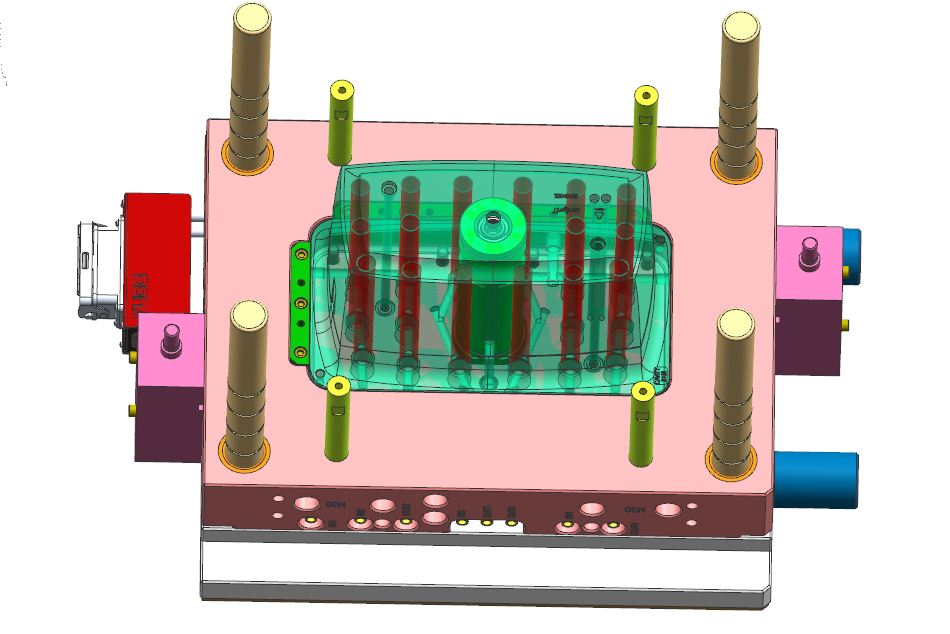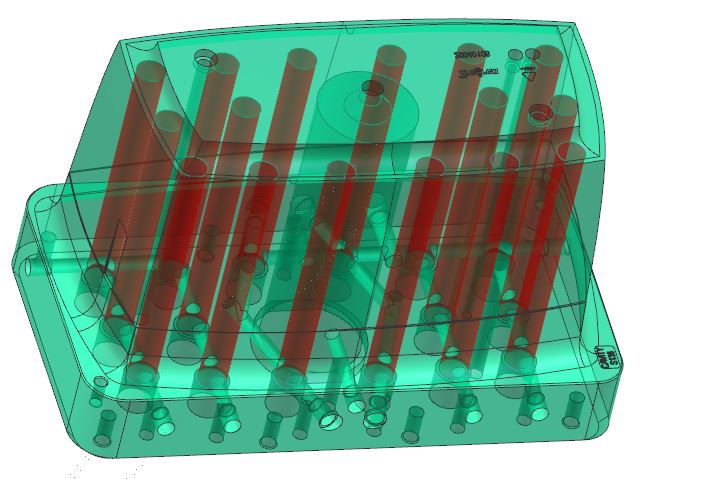What is injection mold Cooling Baffle
Injection Mold cooling baffle in injection molding refers to a component or structure designed to enhance the cooling process of the mold during the injection molding cycle. Injection molding is a manufacturing process where molten plastic is injected into a mold cavity to form a specific shape. Efficient cooling is crucial in this process to ensure proper solidification of the plastic and to achieve high-quality molded parts.
Injection mold cooling baffles are typically positioned within the mold cavity to regulate and optimize the cooling of the injected plastic. These baffles can take various forms, such as fins, channels, or other structures, and are strategically placed to control the flow of coolant (usually water or oil) through the mold. The primary purpose of cooling baffles is to extract heat from the molten plastic rapidly, facilitating faster and more uniform solidification.
By using mold cooling baffles, manufacturers can improve cycle times, enhance the dimensional stability of the molded parts, reduce the risk of defects, and ultimately increase the overall efficiency of the injection molding process. The design and placement of cooling baffles depend on factors such as the geometry of the molded part, the material being used, and the specific requirements of the molding process.

Importance of Injection mold cooling baffle
Mold Cooling baffles play a crucial role in the injection molding process, and their importance lies in several key aspects:
- Cycle Time Reduction: Efficient cooling baffles help in faster and more uniform cooling of the molded part. By optimizing the cooling process, the overall cycle time of the injection molding process can be reduced. Shorter cycle times contribute to increased production rates and improved operational efficiency.
- Dimensional Stability: Proper cooling is essential for achieving dimensional accuracy and stability in the molded parts. Cooling baffles aid in controlling the cooling rate, preventing warping or deformation of the final product. Consistent and controlled cooling helps maintain the desired dimensions of the molded components.
- Quality Improvement: Uniform cooling minimizes the likelihood of internal stresses, sink marks, and other defects in the molded parts. By preventing uneven cooling, cooling baffles contribute to higher-quality finished products with fewer surface imperfections and enhanced structural integrity.
- Material Selection and Processing Optimization: Different materials have distinct cooling requirements. Cooling baffles allow for the customization of the cooling process based on the specific material being used. This flexibility is crucial for optimizing the injection molding parameters and achieving the desired material properties in the final product.
- Energy Efficiency: Efficient cooling baffles contribute to energy savings by allowing for precise control of the cooling process. By cooling the mold more effectively, it is possible to reduce the amount of time the mold spends in the cooling phase, leading to energy efficiency and cost savings over the long term.
- Extended Tool Life: Proper cooling helps in managing the thermal stresses exerted on the mold. By preventing overheating and ensuring even temperature distribution, cooling baffles contribute to the longevity and durability of the injection mold, reducing maintenance costs and downtime.
In summary, Injection mold cooling baffles are essential for optimizing the injection molding process, improving the quality of molded products, reducing cycle times, and enhancing overall operational efficiency in the manufacturing industry.
What do they do for Mold cooling? Bubblers and Baffles
Water cooler bubbler and baffle are sections of cooling lines that divert the coolant flow into areas that would normally lack cooling. Cooling channels are typically drilled through the mold cavity and core. The mold, however, may consist of areas too far away to accommodate regular cooling channels. Alternate methods for cooling these areas uniformly with the rest of the part involved the use of Baffles, Bubblers, or Thermal pins, as shown below.
Baffles
A mold baffle is actually a cooling channel drilled perpendicular to a main cooling line, with a blade that separates one cooling passage into two semi-circular channels. The coolant flows in one side of the blade from the main cooling line, turns around the tip to the other side of the baffle, then flows back to the main cooling line.
This method provides maximum cross sections for the coolant, but it is difficult to mount the divider exactly in the center. The cooling effect and with it the temperature distribution on one side of the core may differ from that on the other side. This disadvantage of an otherwise economical solution, as far as manufacturing is concerned, can be eliminated if the metal sheet forming the baffle is twisted. For example, the helix baffle, as shown in Figure 2 below, conveys the coolant to the tip and back in the form of a helix. It is useful for diameters of 12 to 50 mm and makes for very homogeneous temperature distribution. Another logical development of baffles is single- or double-flight spiral cores, as shown in Figure 2 below.
Bubblers
A mold cooling bubbler is similar to a baffle except that the blade is replaced with a small tube. The coolant flows into the bottom of the tube and “bubbles” out of the top, as does a fountain. The coolant then flows down around the outside of the tube to continue its flow through the cooling channel.
The most effective cooling of slender cores is achieved with bubblers. The diameter of both must be adjusted in such a way that the flow resistance in both cross sections is equal. The condition for this is:
Inner Diameter / Outer Diameter = 0.707
Mold cooling Bubblers are commercially available and are usually screwed into the core, as shown in Figure 3 below. Up to a diameter of 4 mm, the tubing should be bevelled at the end to enlarge the cross-section of the outlet; this technique is illustrated in Figure 3. Bubblers can be used not only for mold core cooling, but are also for cooling flat mold sections, which can’t be equipped with drilled or milled channels.

Figure 3. (Left) Bubblers screwed into the core. (Right) Bubbler bevelled to enlarge the outlet
NOTE: Because both mold cooling baffles and bubblers have narrowed flow areas, the flow resistance increases. Therefore, care should be taken in designing the size of these devices. The flow and heat transfer behaviour for both baffles and bubblers can be readily modelled and analyzed by C-MOLD Cooling analysis.
Thermal pins
A thermal pin is an alternative to Injection mold baffles and bubblers. It is a sealed cylinder filled with fluid. The fluid vaporizes as it draws heat from the tool steel and condenses as it releases the heat to the coolant, as shown in Figure 4. The heat transfer efficiency of a thermal pin is almost ten times as great as a copper tube. For good heat conduction, avoid an air gap between the thermal pin and the mold, or fill it with a highly conductive sealant.
Cooling slender cores
If the diameter or width is very small (less than 3 mm), only air cooling is feasible. Air is blown at the cores from the outside during mold opening or flows through a central hole from inside, this procedure, of course, does not permit maintaining an exact mold temperature.
Better cooling of slender cores (those measuring less than 5 mm) is accomplished by using inserts made of materials with high thermal conductivity, such as copper or beryllium-copper materials. This technique is illustrated in Figure 6 below. Such inserts are press-fitted into the core and extend with their base, which has a cross section as large as is feasible, into a cooling channel.
Cooling large cores
For large core diameters (40 mm and larger), a positive transport of coolant must be ensured. This can be done with inserts in which the coolant reaches the tip of the core through a central bore and is led through a spiral to its circumference, and between core and insert helically to the outlet, as shown in Figure 7. This design weakens the core significantly.
Cooling cylinder cores
Cooling of cylinder cores and other round parts should be done with a double helix, as shown below. The coolant flows to the core tip in one helix and returns in another helix. For design reasons, the wall thickness of the core should be at least 3 mm in this case.

